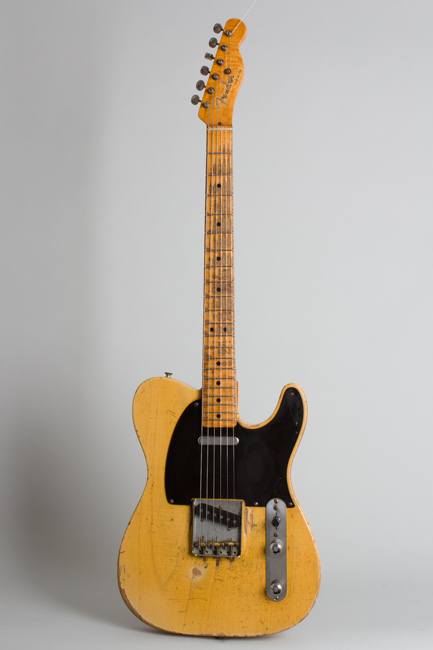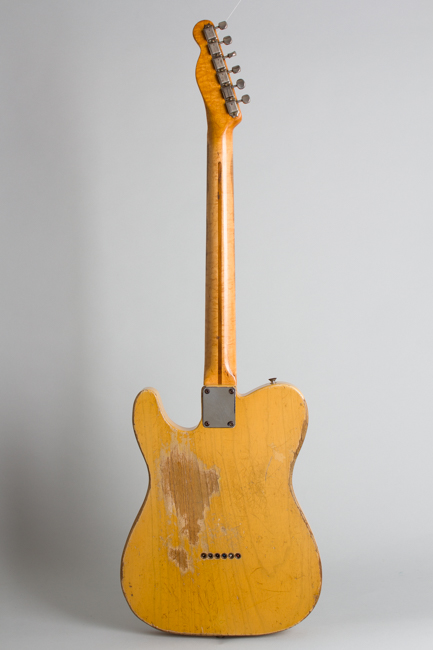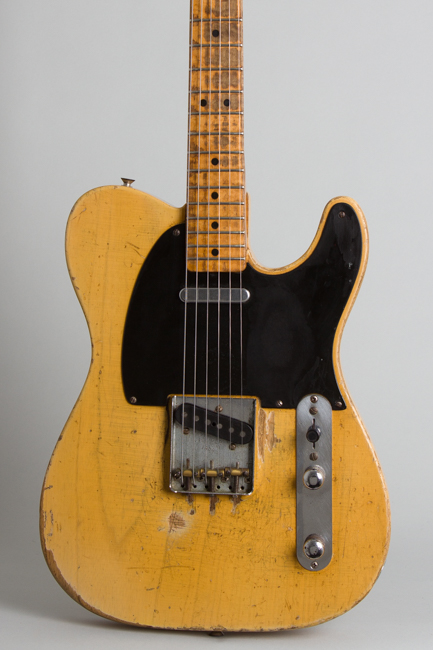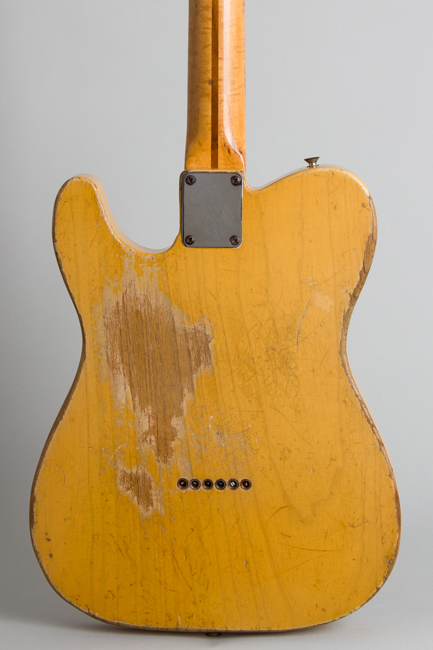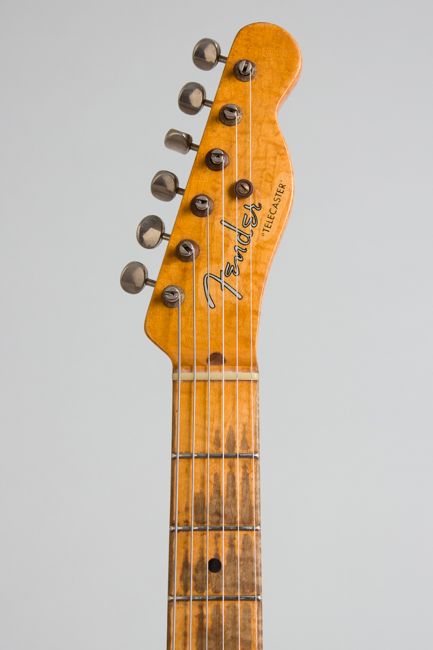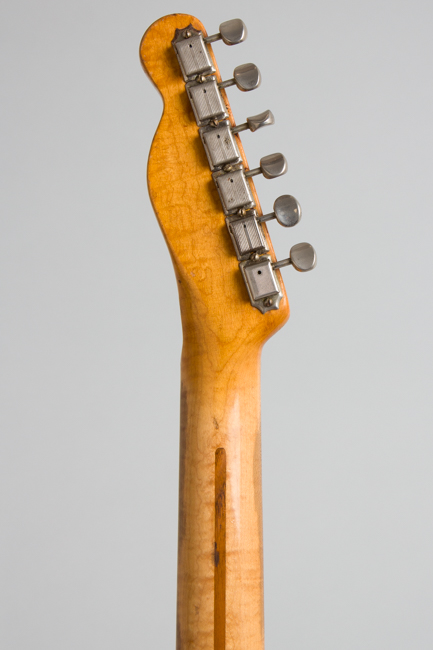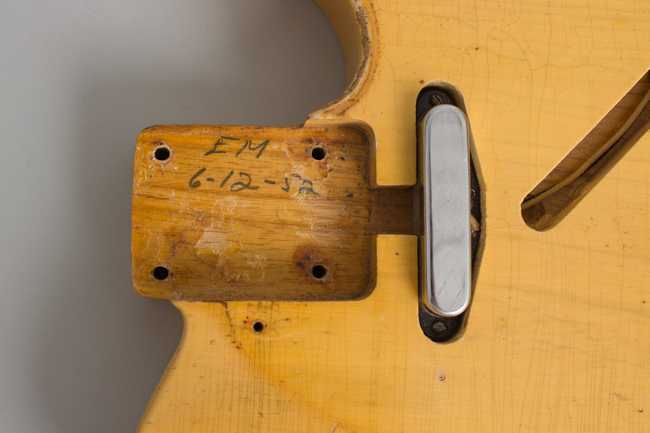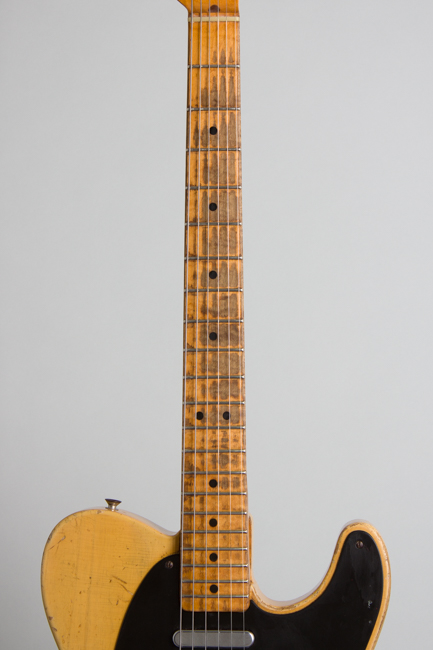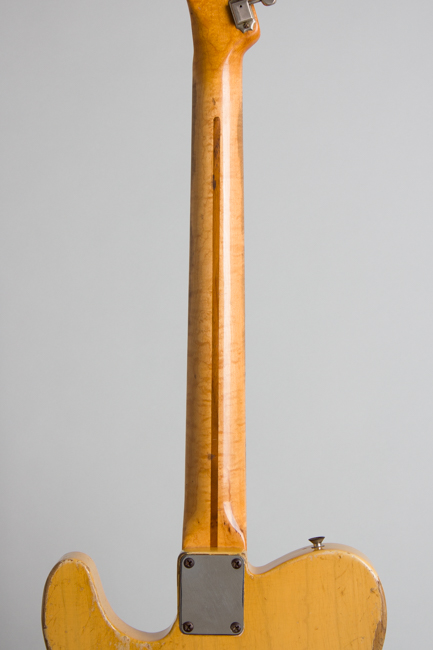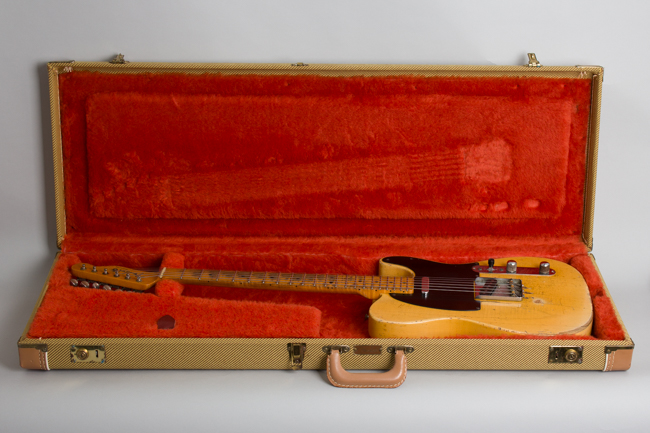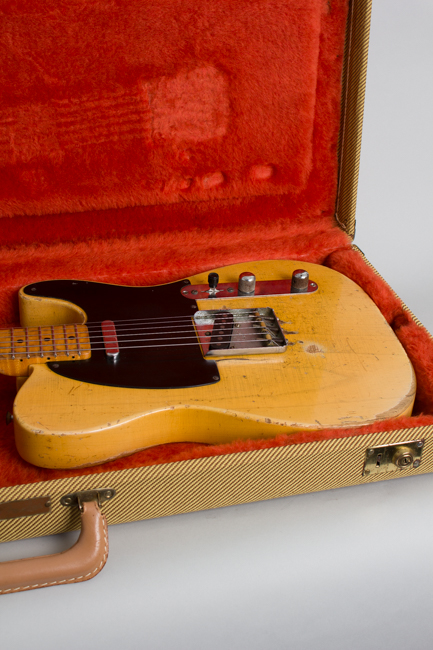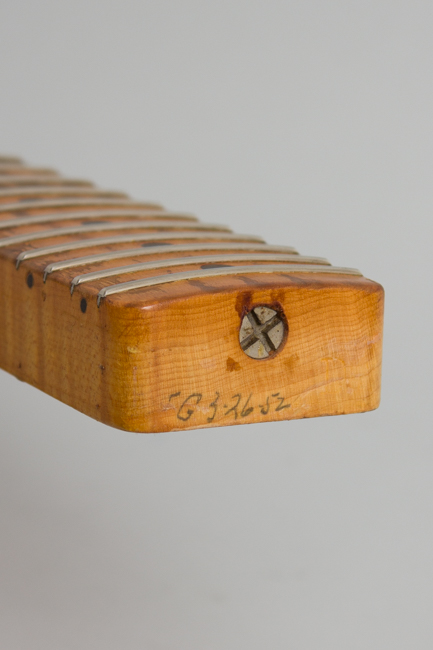Fender Telecaster Solid Body Electric Guitar (1952)
This item has been sold.
Item # 12802
Prices subject to change without notice.
Fender Telecaster Model Solid Body Electric Guitar (1952), made in Fullerton, California, serial # 1484, Blonde lacquer finish, ash body, maple neck, tweed hard shell case.
This is a well-worn "Real relic" example of an original "Blackguard" Telecaster -- the guitar that put Leo Fender on the map. It was built at the company's early cinder-block factory in Fullerton, California in mid-1952. This guitar exhibits all the classic '52 Tele features: the one-piece maple neck, aged "butterscotch" blonde-finished ash body, lacquered black fiber pickguard, brass bridge saddles, and of course a sound for the ages. This guitar has had a refret with larger wire and the bridge pickup recently expertly re-wound by to the original spec. by NY Fender Whisperer Norio Imai, sounding exactly as it should.
The serial number 1484 is stamped into the bridgeplate. The neck is marked 3-26-52 in pencil on the heel alongside the initials of Tadeo Gomez, who signed most of the Fender necks of this period. The body is pencil dated 6-12-52 in the neck cavity, with the initials "EM" found in many Tele and Precision Bass bodies from 1952. The underside of the heel is pencil marked "ESQ" under the finish but the neck carries the "Telecaster" decal on the headstock and was assembled onto a Tele. The tone pot has a date code reading 140-221 designating the 21st week of 1952; the volume pot is a match but the stamp is soldered over.
This guitar has obviously been heavily played since it shipped out of Fullerton in 1952, 70+ years ago. The parts remain original except for the low E tuner, which is a correct repro; the original is in the case and could be remounted but the gear sometimes slips making it impractical to use on a playing instrument. The electronics rig has the original components but has been re-wired to the "modern" Telecaster switching scheme and the bass-heavy "mud cap" removed. As originally set up there is was "deep bass" capacitor on the neck pickup in switch position # 1. As currently set up the neck and bridge pickups can be combined in the middle position, which the original scheme did not allow.
The very comfortable neck has a nice "C" profile, fairly chunky but with a slightly less rounded "throat" in the lower positions than some '52s we have had; it rounds out beautifully as it approaches the body. The screws are mixed flat and Phillips-head types as is customary for 1952; flathead for the pickguard, tuner and pickup mounting, Phillips for the rest. For many, this is THE classic Telecaster year, with the same look and feel of the earliest Fender Broadcaster and "No-Caster" guitars from 1950-51, but more consistent production standards. Many of the fine details of the instrument continued to gradually evolve as the decade went along, but '52 is the benchmark year for comparison to all later Fender guitars, and the year Fender has generally selected for basing its re-issues on.
Before the introduction of the second Fender solid-body (the Stratocaster) in 1954, the Tele and Precision Bass were the company's most innovative and sensational products, and in 1952 were already causing a revolution in playing styles, shaking up the guitar world in a big way. At the time the Telecaster had a totally unique look, feel, and sound, becoming instantly popular particularly with country players. In the years since, many players and collectors have come to consider the 1952 Telecaster the finest electric guitar ever made -- and one of the most historically important as well.
In his authoritative and beautiful book "The Blackguard", author Nacho Banos references this, calling '52s "a personal favorite" and stating, "The neck feel and lead pickup sounds from these ... make them some of the best Fenders ever made". Early Fender Telecasters of this period are universally considered as one of the most desired of all electric guitars, this one while far from pristine is a super playing example with vibe for days.
Overall length is 38 3/4 in. (98.4 cm.), 12 5/8 in. (32.1 cm.) wide at lower bout, and 1 3/4 in. (4.4 cm.) in depth, measured at side of rim. Scale length is 25 1/2 in. (648 mm.). Width of nut is 1 5/8 in. (41 mm.).
Overall this is a fine playing example showing fairly extensive wear and tear and some careful restoration as noted. The original thin lacquer finish on the body is ambered and checked showing an extensive collection of dings, dents, and worn spots, heavily to the edges as usual with a large belt buckle wear area on the back. The face shows finger wear into the wood in the "pinky anchor" spot below the bridge and the small worn channels behind the bridge screws from many intonation adjustments, just as Roy Buchanan's Tele did! Just behind this is another circular worn-through spot from a wristlet the previous owner wore.
The thin clear lacquer finish on the fingerboard shows heavy wear down to the wood up to well above the 12th fret, again common on 1950s Telecasters and the mark of having belonged to a "hotshot" (not "Cowboy Chord") player. The back of the neck is worn to the wood on both sides but still retains more original lacquer than some. The guitar has been refretted with somewhat larger wire than '50s spec, but not wide '80s style jumbos. There does not appear to be any overspray to the neck or fingerboard accompanying this, or if so it has been worn off again. These frets are taller then vintage spec and very playable but could be lowered and re-crowned to taste if desired. The bone nut is newer as well.
The fiber pickguard has wear into the lacquer over much of the surface. The brass bridge saddles and screws have some corrosion and discoloration but nothing is rusted hard and all adjustment screws remain functional. As noted the lead pickup was recently rewound to exact original spec after it failed; this was done by Norio Imai, the receipt is in the case confirming his work. The original windings are included for history's sake in a baggie in the case. Some solder joints have been redone due to the re-wiring but the internal components remain original. All other hardware remains original with the exception of the substitute low E tuner; The "ashtray" bridge cover is long gone.
This instrument shows heavy wear from years of hard gigging, but retains the original character and a "Real Relic' look par excellence. These were unique instruments when new, often "played to death," and the majority of survivors have not only been heavily used but also commonly modified or altered. This one retains a largely original character and is a fantastic-sounding guitar that twangs sweetly as required and can really rip when pushed. The frets fitted allow a modern player to really dig in more than the original style did, ready to go without the worry of replacing worn originals. It resides in an older re-issue Fender tweed case. Overall Very Good Condition.
This is a well-worn "Real relic" example of an original "Blackguard" Telecaster -- the guitar that put Leo Fender on the map. It was built at the company's early cinder-block factory in Fullerton, California in mid-1952. This guitar exhibits all the classic '52 Tele features: the one-piece maple neck, aged "butterscotch" blonde-finished ash body, lacquered black fiber pickguard, brass bridge saddles, and of course a sound for the ages. This guitar has had a refret with larger wire and the bridge pickup recently expertly re-wound by to the original spec. by NY Fender Whisperer Norio Imai, sounding exactly as it should.
The serial number 1484 is stamped into the bridgeplate. The neck is marked 3-26-52 in pencil on the heel alongside the initials of Tadeo Gomez, who signed most of the Fender necks of this period. The body is pencil dated 6-12-52 in the neck cavity, with the initials "EM" found in many Tele and Precision Bass bodies from 1952. The underside of the heel is pencil marked "ESQ" under the finish but the neck carries the "Telecaster" decal on the headstock and was assembled onto a Tele. The tone pot has a date code reading 140-221 designating the 21st week of 1952; the volume pot is a match but the stamp is soldered over.
This guitar has obviously been heavily played since it shipped out of Fullerton in 1952, 70+ years ago. The parts remain original except for the low E tuner, which is a correct repro; the original is in the case and could be remounted but the gear sometimes slips making it impractical to use on a playing instrument. The electronics rig has the original components but has been re-wired to the "modern" Telecaster switching scheme and the bass-heavy "mud cap" removed. As originally set up there is was "deep bass" capacitor on the neck pickup in switch position # 1. As currently set up the neck and bridge pickups can be combined in the middle position, which the original scheme did not allow.
The very comfortable neck has a nice "C" profile, fairly chunky but with a slightly less rounded "throat" in the lower positions than some '52s we have had; it rounds out beautifully as it approaches the body. The screws are mixed flat and Phillips-head types as is customary for 1952; flathead for the pickguard, tuner and pickup mounting, Phillips for the rest. For many, this is THE classic Telecaster year, with the same look and feel of the earliest Fender Broadcaster and "No-Caster" guitars from 1950-51, but more consistent production standards. Many of the fine details of the instrument continued to gradually evolve as the decade went along, but '52 is the benchmark year for comparison to all later Fender guitars, and the year Fender has generally selected for basing its re-issues on.
Before the introduction of the second Fender solid-body (the Stratocaster) in 1954, the Tele and Precision Bass were the company's most innovative and sensational products, and in 1952 were already causing a revolution in playing styles, shaking up the guitar world in a big way. At the time the Telecaster had a totally unique look, feel, and sound, becoming instantly popular particularly with country players. In the years since, many players and collectors have come to consider the 1952 Telecaster the finest electric guitar ever made -- and one of the most historically important as well.
In his authoritative and beautiful book "The Blackguard", author Nacho Banos references this, calling '52s "a personal favorite" and stating, "The neck feel and lead pickup sounds from these ... make them some of the best Fenders ever made". Early Fender Telecasters of this period are universally considered as one of the most desired of all electric guitars, this one while far from pristine is a super playing example with vibe for days.
Overall length is 38 3/4 in. (98.4 cm.), 12 5/8 in. (32.1 cm.) wide at lower bout, and 1 3/4 in. (4.4 cm.) in depth, measured at side of rim. Scale length is 25 1/2 in. (648 mm.). Width of nut is 1 5/8 in. (41 mm.).
Overall this is a fine playing example showing fairly extensive wear and tear and some careful restoration as noted. The original thin lacquer finish on the body is ambered and checked showing an extensive collection of dings, dents, and worn spots, heavily to the edges as usual with a large belt buckle wear area on the back. The face shows finger wear into the wood in the "pinky anchor" spot below the bridge and the small worn channels behind the bridge screws from many intonation adjustments, just as Roy Buchanan's Tele did! Just behind this is another circular worn-through spot from a wristlet the previous owner wore.
The thin clear lacquer finish on the fingerboard shows heavy wear down to the wood up to well above the 12th fret, again common on 1950s Telecasters and the mark of having belonged to a "hotshot" (not "Cowboy Chord") player. The back of the neck is worn to the wood on both sides but still retains more original lacquer than some. The guitar has been refretted with somewhat larger wire than '50s spec, but not wide '80s style jumbos. There does not appear to be any overspray to the neck or fingerboard accompanying this, or if so it has been worn off again. These frets are taller then vintage spec and very playable but could be lowered and re-crowned to taste if desired. The bone nut is newer as well.
The fiber pickguard has wear into the lacquer over much of the surface. The brass bridge saddles and screws have some corrosion and discoloration but nothing is rusted hard and all adjustment screws remain functional. As noted the lead pickup was recently rewound to exact original spec after it failed; this was done by Norio Imai, the receipt is in the case confirming his work. The original windings are included for history's sake in a baggie in the case. Some solder joints have been redone due to the re-wiring but the internal components remain original. All other hardware remains original with the exception of the substitute low E tuner; The "ashtray" bridge cover is long gone.
This instrument shows heavy wear from years of hard gigging, but retains the original character and a "Real Relic' look par excellence. These were unique instruments when new, often "played to death," and the majority of survivors have not only been heavily used but also commonly modified or altered. This one retains a largely original character and is a fantastic-sounding guitar that twangs sweetly as required and can really rip when pushed. The frets fitted allow a modern player to really dig in more than the original style did, ready to go without the worry of replacing worn originals. It resides in an older re-issue Fender tweed case. Overall Very Good Condition.
